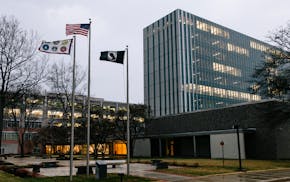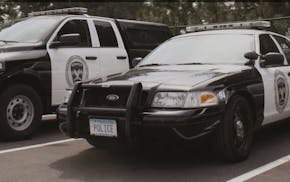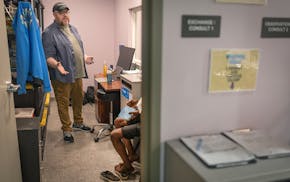The Minnesota Department of Transportation has been searching for a Dakota nation to accept ownership of the Wall of Forgotten Natives. But with no definitive taker so far, the department plans to expand outreach efforts this spring.
"We've really got to be careful and cautious and conscious of what actions we take and how we do them, and that takes time to have conversations with community members and tribal nations," said MnDOT tribal liaison Levi Brown. "We definitely need to do something. It's just we don't know what that is yet."
The Wall of Forgotten Natives is a strip of vacant land beside Hwy. 55 in Minneapolis. Slightly larger than an acre, it is separated from a residential neighborhood by a sound wall. The property has been the site of homeless encampments since 2018, when an upside-down American flag was flown there for months, signaling distress in the community.
The Minnesota Department of Transportation has considered finding another owner for the wall since 2019. At that time, its staff began to explore the process of having it deemed a "surplus" property — no longer needed for highway purposes — and legally eligible for transfer to another political subdivision like a city or county, state agency or tribal government.
MnDOT's communications staff declined to answer questions about what initiated the process of designating the wall as surplus, what factors were considered, and what other MnDOT lands are available for land back, the movement to restore Indigenous control of ancestral lands.
In the summer of 2023, as MnDOT prepared to sweep another encampment from the wall under its no-tolerance policy for staying on highway right-of-way, community activist Mike Forcia proposed that MnDOT grant the land to the American Indian Movement. He asked MnDOT to postpone the sweep until the transfer could be done.
"We would have it all cleaned out," Forcia said, describing his vision for the wall in a recent interview with the Minnesota Star Tribune. "And then we plant our own tobacco, sage, cedar, sweet grass, our medicines. And then we plant pear trees and plum trees and turn it into a memorial garden for all those people we lost on that wall."
Transportation Commissioner Nancy Daubenberger told Forcia that MnDOT was willing to engage in the land back process but that it would be lengthy and people would not be allowed to camp there in the meantime.
Internally, Daubenberger asked staff to prepare for broad conversations about land back at the wall now that there was "heightened interest" in it. "We'll need to continue to impress upon [Forcia] that while we discuss this with AIM, we also will be discussing with all our tribal partners — no guarantee the land will go to AIM," Daubenberger wrote.
That fall, MnDOT met with the Minneapolis Public Housing Authority and the city of Minneapolis to discuss their assuming ownership of the wall if no tribe came forward to claim it.
There was precedence for such a transfer, said MnDOT ombudsman Jim Skoog in an email to Erik Hansen, then director of Minneapolis Community Planning and Economic Development. In 2007, MnDOT transferred property at Hwy. 55 and 26th Street to the city, which then transferred it to Little Earth of United Tribes for greenhouses.
Skoog said he also hoped to learn about Minneapolis' recent sale of two abandoned properties to the Red Lake Band of Chippewa Indians for $1 each. In the past, the city has occasionally offered developers steep discounts, including $1 transfers, of otherwise hard-to-develop parcels in hopes of building needed facilities in low-income and minority communities.
At internal meetings months later, MnDOT staff confirmed that no other government entities had stepped forward to acquire the wall.
Still, meeting minutes show staff hoped to resolve two central questions: "How can we put MnDOT in a position so that MnDOT is not owners of record," and "If MnDOT can't convey to local partners, how can MnDOT Metro mitigate legal liability to allow community use of the area?"
MnDOT published an online survey in summer 2024 asking members of the public whether they would like the land to go to the Shakopee Mdewakaton, Prairie Island, Lower Sioux or Upper Sioux tribal government.
None of the Dakota tribes responded to the Star Tribune saying it had an interest in owning the land.
Council Member Jason Chavez, who represents the area, said he had constituents who were open to ideas of using the wall for more public benefit. He encouraged MnDOT to have open dialogue with broader East Phillips residents, saying he was unaware of public outreach beyond the survey.
"The potential transfer of public land to a Dakota or Lakota nation doesn't correct the history of genocide and oppression; it represents a significant step towards honoring the Indigenous communities' deep historical and cultural connection to the land," Chavez said in a statement. "Any decision should be rooted in mutual respect, collaboration and a commitment to reconciliation."
According to Brown, the tribal liaison, MnDOT is planning to release more information this spring, but does not yet have a plan to share.

Trump races to fix a big mistake: DOGE fired too many people

St. Paul sees 'unprecedented' day care closures, sending families scrambling

One man dead in shooting Friday outside Northtown Mall in Blaine

Four arrested, no one injured in fighting and shooting following Burnsville High School graduation

